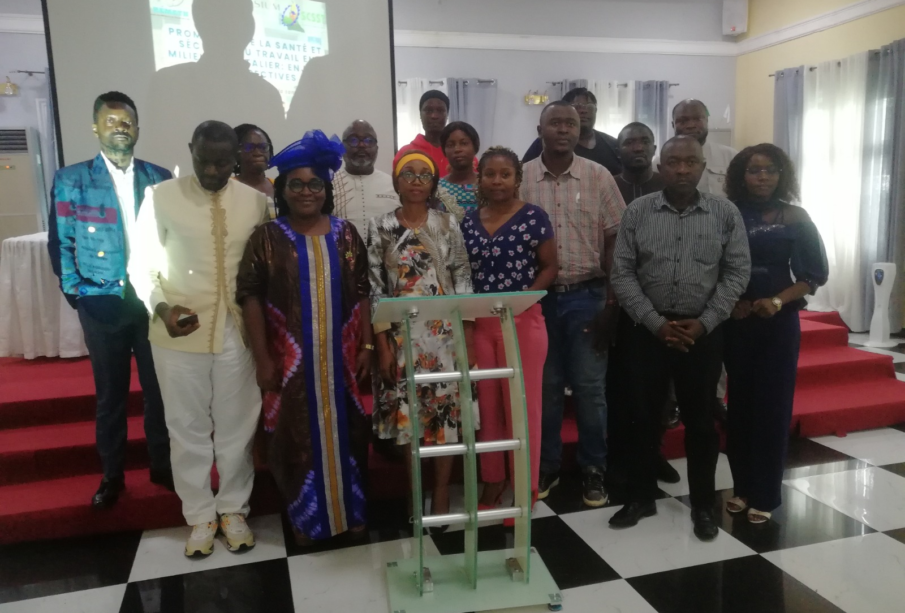Safety at work in hospitals Douala hosts first-ever symposiu

Laquintinie Hospital Douala on July 12,2024. hosted the first symposium on occupational health and safety in hospitals. The aim was to discuss the issues at stake and look to the future.
As a result of climate change, workers around the world are exposed to risks such as heat stress, ultraviolet rays, air pollution, extreme weather events, vector-borne diseases and contaminating substances. Indeed, climate change is leading to numerous health problems, such as cancer, cardiovascular disease, respiratory illnesses and mental health disorders. On 12 July 2024, the conference room at Douala’s Laquintinie Hospital hosted the first symposium on health and safety at work in hospitals.
Exposure of healthcare professionals to microbes and viruses in the hospital environment will also be on the agenda. Among the range of topics on the agenda, two caught our attention. These are occupational risks in the hospital and the analysis of workstations. “Biological risks linked to exposure to biological agents”, in particular viruses such as the hepatitis virus and the AIDS virus. There are bacteria to which health workers can be exposed, in particular the one responsible for tuberculosis. There are other infectious agents to which workers are exposed. Psychosocial risks are increasingly predominant. Psychosocial risks. “Risks related to the working environment, physical risks and risks related to the working atmosphere”, explained Dr Eunice Kamto.
The work of healthcare staff is not simply a matter of carrying out tasks. “All hospital practitioners must be taken into account when it comes to their health and safety at work,” said Dr Ginette Tuayon, President of the Réseau des médecins du travail des hôpitaux (REMETH). To mark World Day for Safety and Health at Work 2024, the International Labour Organisation (ILO) will be launching a new report entitled “Ensuring safety and health at work in a changing climate”, which will reveal alarming new data on the impact of climate change on workers’ lives. “How can a doctor provide care if he or she is not healthy? How can nurses provide care if they themselves are not healthy? If a nurse provides care and then quickly falls ill because he or she does not have the conditions required to provide that care properly, he or she will stop work. And who is going to look after the public if the nurses and doctors are all ill?” she asked, adding that “… the primary beneficiaries of health and safety at work should be hospital carers…”. “Caregivers must be healthy”, she maintains.
Behind the scenes at the meeting, we learn that a document will be drawn up to protect the health and safety of nursing staff and will be submitted to the Cameroonian authorities to ensure the health and safety of workers in the country’s hospitals.
Alphonse JENE
Reaction

Dr Eunice Mboufang Épse Kamto
“The most common risk is biological”.
According to the general practitioner on duty at the gynaecological, obstetric and paediatric hospital in Douala, health professionals working in health facilities are exposed to hepatitis, AIDS and tuberculosis viruses.
What occupational risks have you identified so far?
As I said in my short presentation, the most common risks in the hospital environment, since that’s what we’re talking about today, are biological risks. These are really priority risks, biological risks linked to exposure to biological agents, in particular viruses such as the hepatitis virus and the AIDS virus. There are also other bacteria to which healthcare workers may be exposed, in particular that responsible for tuberculosis.
There are other infectious agents to which workers are exposed. As well as biological risks, there are also psychosocial risks, which are becoming more and more predominant, because with the environment becoming increasingly stressful, both economically and socially, everything is going to react and spill over onto the health worker. Psychosocial risks are also fairly common in the workplace.
Not to mention the risks associated with the working environment, physical risks and risks associated with the working atmosphere. There really are a lot of risks to which workers are exposed, particularly hospital workers.
Is it possible to avoid all this? How?
There is no such thing as zero risk. That’s what you need to know. But of course they can be avoided. That’s what occupational medicine is all about, offering employers effective preventive measures to protect workers’ health.
You need to know what the risks are, what the solutions are, what the preventive measures are, and above all you need to inform the employer and the worker about these preventive measures. When workers are informed and trained, some of these risks can be largely avoided. But as you said earlier, we still need to take a few measures, because we’re working in a service context.
Yes, there are several measures. There are collective and individual measures. The collective measure, for example, is already to avoid sources of danger, be they physical, environmental, noise or light-related.
You already have to be able to comply with standards, because there are international standards. For example: noise, temperature, lighting. If you already comply with the standards, you can limit the risks to which the worker is exposed. And now, at the individual level, workers need to know what measures they need to take to minimise their exposure. And then, very importantly, there’s the protective equipment that the worker has to wear, particularly in relation to biological risks. Personal protective equipment is essential to protect against these risks.
You emphasised on the risk of noise, which are so recurrent these days, with telephones and loudspeakers everywhere. Do you include all this in the list of things to avoid, in hospital settings for example?
Yes, it’s true that the risk of noise in the hospital environment is not one of the greatest risks, but it can be a serious one. I’ve been told that the risk linked to lighting may be an even greater risk, or the risk linked to other factors, particularly psychosocial risks, as has been mentioned. But all these risks are taken into account and vary according to the work environment and health training.
All these risks are taken into account, are already assessed and then taken into account in prevention strategies.
Have you thought about the use of mobile phones in hospitals too? What kind of risk does it pose?
As we’ve said, this can lead to disorganisation, problems in the organisation of care, slowness at work and a loss of productivity, so these are all things that we need to know how to limit and use properly.
Interview by A.J.















